AUCTORES
Globalize your Research
Research Article | DOI: https://doi.org/10.31579/2690-4861/259
Department of Pharmaceutical Chemistry, Faculty of Pharmacy, AIMST University, Kedah D.A., Malaysia.
*Corresponding Author: Nabila Perveen, Department of Pharmaceutical Chemistry, Faculty of Pharmacy, AIMST University, Kedah D.A., Malaysia.
Citation: Tan T. Chang, Nabila Perveen N., Naeem H. Khan (2022) Antimicrobial, Total Phenolic Content and Free Radical Scavenging Activity Determination of the Centella asiatica extract. International Journal of Clinical Case Reports and Reviews. 12(2); DOI: 10.31579/2690-4861/259
Copyright: © 2022 Nabila Perveen, this is an open-access article distributed under the terms of the Creative Commons Attribution License, which permits unrestricted use, distribution, and reproduction in any medium, provided the original author and source are credited.
Received: 19 September 2022 | Accepted: 03 October 2022 | Published: 10 November 2022
Keywords: centella asiatica; DPPH; Phenolic content; antimicrobial
Centella asiatica is a popular medicinal plant that has a long history of usage as a traditional medicine that is used for neurological disease, skin disease, immune disease, and others. Nowadays, there is a wide array of Centella asiatica -based products. Although Centella asiatica was claimed to be having an established profile on the free radical scavenging activity, total phenolic content and antimicrobial activity of Centella asiatica but there is still a lack of detailed study that focuses on those properties. This study aims to fill the gap in the previous research, especially on the antimicrobial activity of C. asiatica. This study is worth examining because it helps to assure the effectiveness of C. asiatica medicinal products on the market. The antioxidant activity and total phenolic content of the plant extract were examined by using DPPH assay and Folin-Ciocalteu method respectively. Based on the findings, C. asiatica was found to be having concentration-dependent antioxidant activity with the highest radical scavenging activity recorded at 52.7% at 100 μg/mL. For total phenolic concentration wise, 1mg/ml maceration and soxhlet extract of C. asiatica were found to be having 20.74 and 27.48 μg/mL Gallic acid equivalent (GAE) respectively. The antimicrobial activity was determined by using the modified broth dilution method. Based on the findings, C. asiatica was found to be effective against E. coli, K. pneumonia, and S. epidermidis with the MIC recorded at 4mg/ml. On the other hand, B.pumilus did not portray
sensitivity against C. asiatica at the tested concentration. This study is significant as it verifies the antioxidant activity, total phenolic content, and antimicrobial activity of the plant extract successfully.
Centella asiatica is an herbaceous, perennial plant that belongs to family Apiaceae. The other scientific name of Centella asiatica include Centella erecta, Hydrocotyle asiatica L., Hydrocotyle erecta, and Centella repanda. It also has a wide variety of common names include Asiatic pennywort, Indian Pennywort, and Goyu Kola. The Chinese common name of Centella asiatica is Ji Xue Cao. In India, it is known as Brahmi or Thankuni. It is widely found in tropical region such as China, India, Sri Lanka, Africa, Malaysia, Myanmar and Vietnam. Centella asiatica has a long history of usage in these countries. Apart from medicinal use, Centella asiatica has been used as an ingredient of local cuisine in these countries. For example, in Malaysia, Centella asiatica is one of the ingredients used to prepare “Ulam”, which is a type of salad taken by Malaysian. The taxonomical classification of Centella asiatica is depicted in Table 1 [1].
| Domain | Eukaryota |
| Kingdom | Plantae |
| Phylum | Spermatophyta |
| Subphylum | Angiospermae |
| Class | Dicotyledonae |
| Order | Apiales |
| Family | Apiaceae |
| Genus | Centella |
| Species | Centella asiatica |
Table 1 : Botanical features of Centella asiatica
The plant prefers relatively shady and damp habitat such as wetland, riversides, ponds, wet
Meadows, forest and can adapt to an altitude from 300m to 1800m [2]. Figures 1-2 shows the leaves and flowers of Centella asiatica.
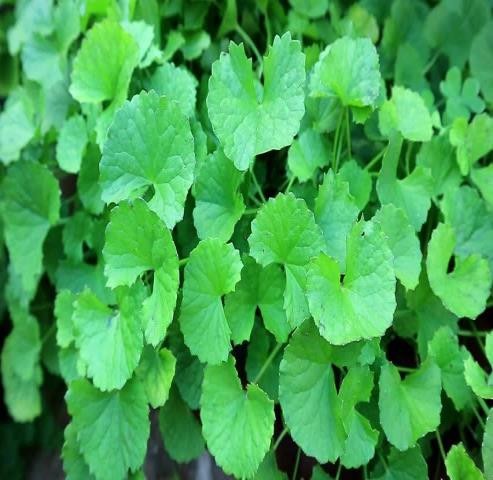
Figure 1: Centella asiatica asiatica asiatica leaves
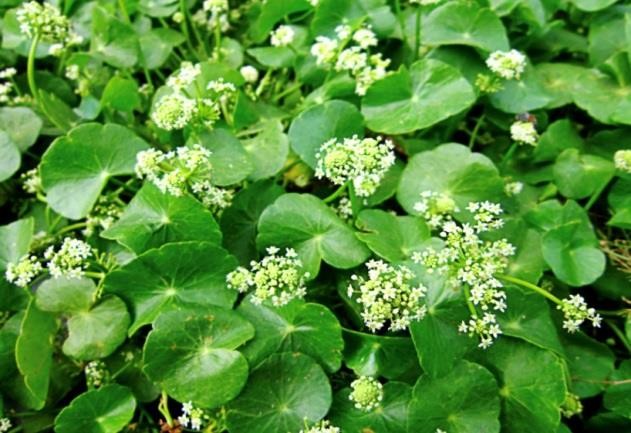
Figure 2: Top View of Centella asiatica flower
It was also traditionally being used to treat gastrointestinal disease, sleep disorder, tuberculosis and diabetes [3].
Centella asiatica is known to have a rich phytochemical content. Majority of compound found in this plant belong to a chemical class known as triterpene saponosides. For instance, asiatic acid, madecassic acid, asiaticoside, madecassoside, madasiatic acid, betulinic acid, thankunic acid and isothankunic acid. These triterpene molecules are responsible for the biological properties such as increasing cellular hyperplasia, collagen production and also the anti-inflammatory properties of Centella asiatica. Flavonoid derivative such as quercetin, kaempferol, patuletin, rutin, apigenin, castilliferol and others are also being found in Centella Asiatica. Other compound such as polysaccharides, polyacetylenes, sterol, tannis, fatty acid has also been successfully isolated from the plant [4–6]. Centella asiatica also displayed a wide array of pharmacological properties. It has prominent anti-inflammatory, anti-oxidant and antimicrobial properties, which will be discussed further in this paper. Apart from that, it is also claimed to have anti-rheumatic, antipyretic, diuretic and antiviral properties which is evidenced from its wide array of traditional use [3].
Collection of Centella asiatica
Dried Centella asiatica were purchased from traditional herbal shop. The dried leaves were identified and authenticated. Then the dried leaves were cut into small pieces and grinded into fine pieces by using an electronic grinder. After that, the grinded leaves of C. asiatica were weighed by using a digital weightbalance. The weightof the dried, grinded Centella asiatica leaves was found to be 207.3 gram and the weight was recorded. The grinded dried leaves were placed into a basket under room temperature for 1 day to ensure all the extracts were completely dried and free from moisture.
Preparation of Centella asiatica extract Maceration
75 grams of Centella asiatica leaves powder were added into a 1-liter conical flask and 600 ml ethanol.. The procedure above was repeated in order to have 2 set of maceration setup. Thus, a total of 150 gram of C. asiatica leaves and 1200 ml of ethanol were used for the maceration process of C. asiatica. After that, the mixture was allowed to stand for 7 days at room temperature in a dark cabinet. The mixture was shaken daily in order to create a homogenous mixture and ensure that all the contents of C. asiatica were extracted into the ethanol solution. After 7 days, the mixture was subjected to filtration by using muslin clothes. The ethanolic extract was then be subjected to evaporation process in order to get a concentrated extract.
Hot percolation (Soxhlet extraction)
25 grams of Centella asiatica powder was packed into thimble made from a strong filter paper or cellulose. Solvent ethanol was poured into round-bottom flask and connected to the lower opening of Soxhlet extractor. The temperature was controlled at around 70- 75°C as the boiling point of ethanol was around 78.3. This can ensure that only ethanol evaporated and minimum deterioration occurs to the plant phytochemical. Extraction occurred through direct contact between extraction solvent and the plant power. The entire process was continued for around 12 hours [7].
Evaporation of ethanolic extract
The temperature was set at 60°C and the rotation per minutes (rpm) of the evaporator was controlled at 100. The process was continued until a thick, viscous extract was obtained. The products were then put into evaporating dish and the evaporating dish was covered with aluminium foil. The temperature of the hot air oven was set at 45 °C to allow further evaporation of the ethanol solvent to occur gently. This process was continued until a viscous, thick paste of the extract was obtained [8].
Test for free-radical scavenging activity DPPH assay
DPPH assay is a method that deploy stable free radical which is 2, 2-diphenyl-1- picrylhydrazyl (C18H12N5O6) to determine the antioxidant activity of the tested compound. In this test, the scavenging capacity of antioxidant towards DPPH will be measured. The odd electron of nitrogen atom in DPPH is reduced by receiving a hydrogen atom from antioxidant to the corresponding hydrazine. Therefore, DPPH assay is actually related to the hydrogen donating ability of the tested extract. DPPH will produce violet color in methanol solution but fades to shades of yellow color upon scavenged. The procedure for conducting DPPH assay was mentioned below [9].
Preparation of different concentration of extract and ascorbic acid solution
1 mg/ml C. asiatica stock solution was prepared by dissolving 100 mg of C. asiatica extract obtained from maceration process, which was in viscous paste form, in 100 ml of ethanol solution. After that, serial dilution process was carried out to prepare six different concentration of C. asiatica solution which were 10, 20, 40, 60, 80 and 100 μg/ml respectively. The different concentration of C. asiatica solution was prepared by mixing different volume of the stock solution with different volume of ethanol as shown in the Table2.
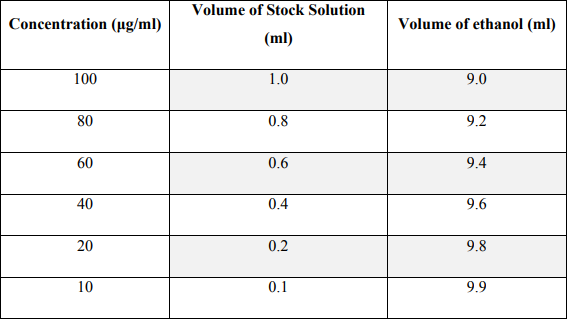
Table 2: Formulae for different dilution of C.asiatica extract
The total volume of different dilution should be 10 ml. The C. asiatica solution was stored in a 10 ml volumetric flask for further use. The process was repeated by using the Soxhlet extract of C. asiatica and also ascorbic acid (9).
Preparation of 1,1-Diphenyl-2-picryl hydrazyl (DPPH) solution
0.3 mM of DPPH reagent was prepared by dissolving 11.83 mg in 100 ml of ethanol.
DPPH assay procedure
2.5 ml of different concentrations of maceration extract of C. asiatica were added into 6 separate test tubes. All the test tubes were then covered with aluminium foil as DPPH is a photosensitive reagent. After that, 1 ml of 0.3 mM of alcoholic reagent of DPPH was added into the test tubes. The test was performed in triplicate for each concentration of maceration extract of C. asiatica. The procedure mentioned above was repeated with the Soxhlet extract of C. asiatica and ascorbic acid solution. Similarly, control solution was prepared by replacing the extract with ethanol and addition of 1ml of 0.3 mM of alcoholic solution of DPPH. A blank solution was prepared only with 3ml of 95% ethanol. All the test tubes containing the preparation mentioned above were allowed to stand for 30 minutes in dark cupboard. The absorbance at 518nm of different preparations was studied by using UV- Visible spectrophotometer. The test needed to be performed in a dark condition. The absorbance values of each different concentration of standard ascorbic acid, C. asiatica extract, control and blank were recorded. The free radical scavenging activity of different concentration of C. asiatica extract was calculated by using the formulae given below (10,11).
DPPH Radical Scavenging Activity (%) = (Acontrol - Asample)/Acontrol ×100
Result of DPPH assay

Table 4: Result of DPPH assay of C. asiatica maceration extract
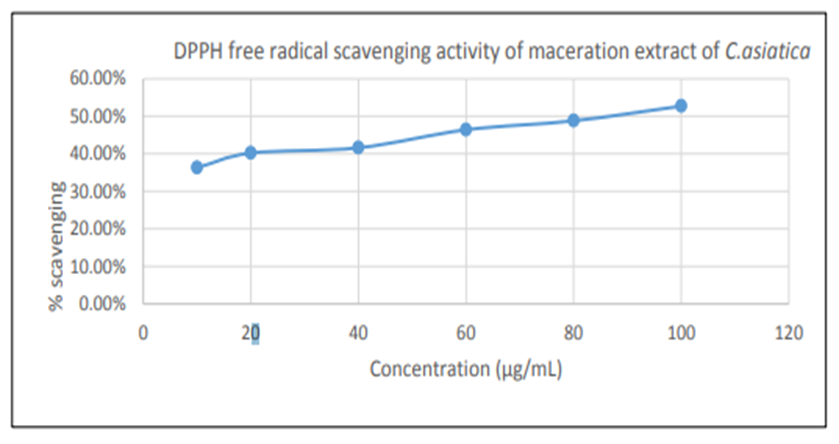
Graph 1: Free radical scavenging against concentration of maceration extract of C. asiatica

Table 5: Result of DPPH assay of C. asiatica soxhlet extract
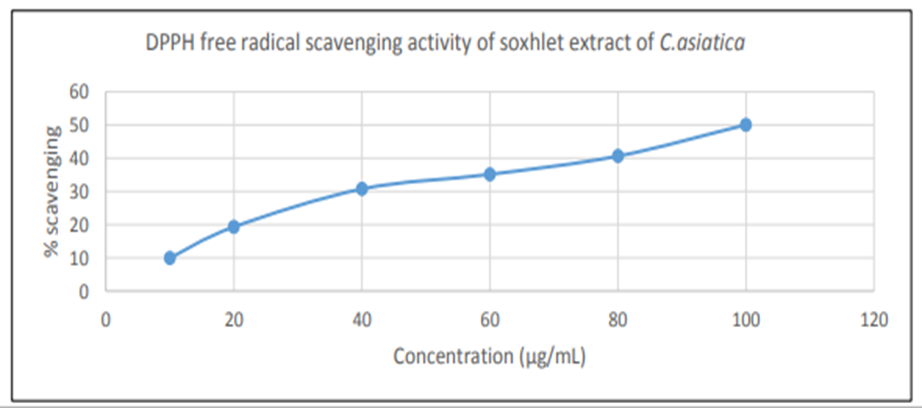
Graph 2: DPPH free radical scavenging against concentration of soxhlet extract of C. asiatica

Table 6: Result of DPPH assay of ascorbic acid
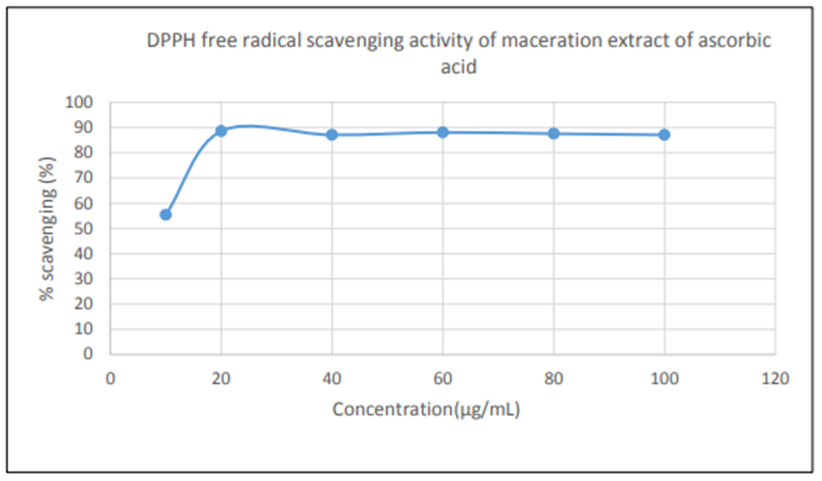
Graph 3 : DPPH free radical scavenging activity of maceration extract of ascorbic acid
Result of Total Phenolic Content
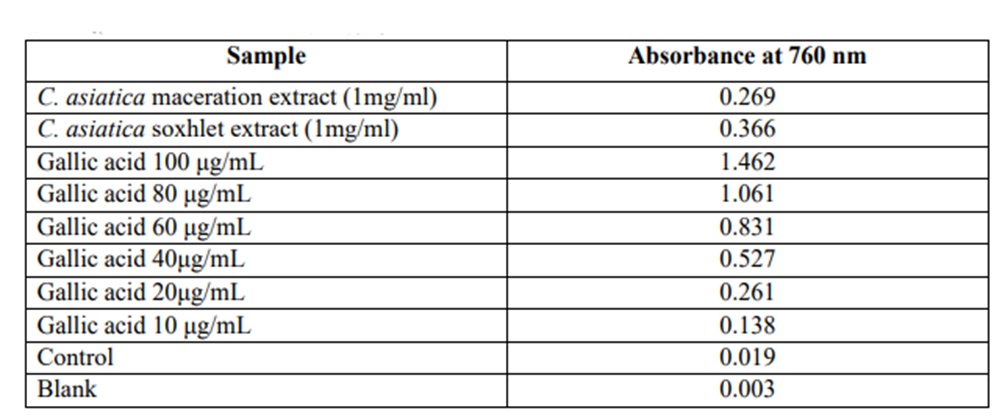
Table 7: Absorbance value of extract. Gallic acid, control and blank
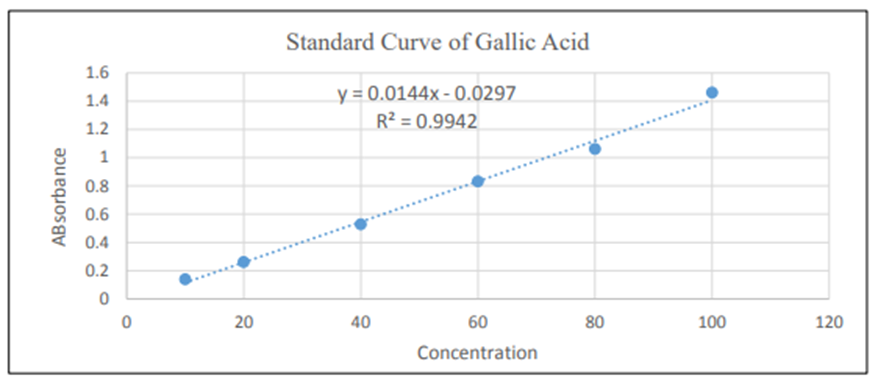
Graph 4 : Standard curve of Gallic acid
Calculation of total phenolic content in C.asiatica extract
Given,
y = 0.0144x - 0.0297, where x=concentration of phenolic compound, y = absorbance value Maceration extract, absorbance =0.269,
Concentration of phenolic compound = (0.269+0.0297) /0.0144
=20.74 μg/ml Gallic acid equivalent
Soxhlet extract, absorbance = 0.366
Concentration of phenolic compound = (0.366+0.0297)/0.0144
= 27.48 μg/mL Gallic acid equivalent
Result for antimicrobial activtiy

Antimicrobial acitivity against Escherichia coli
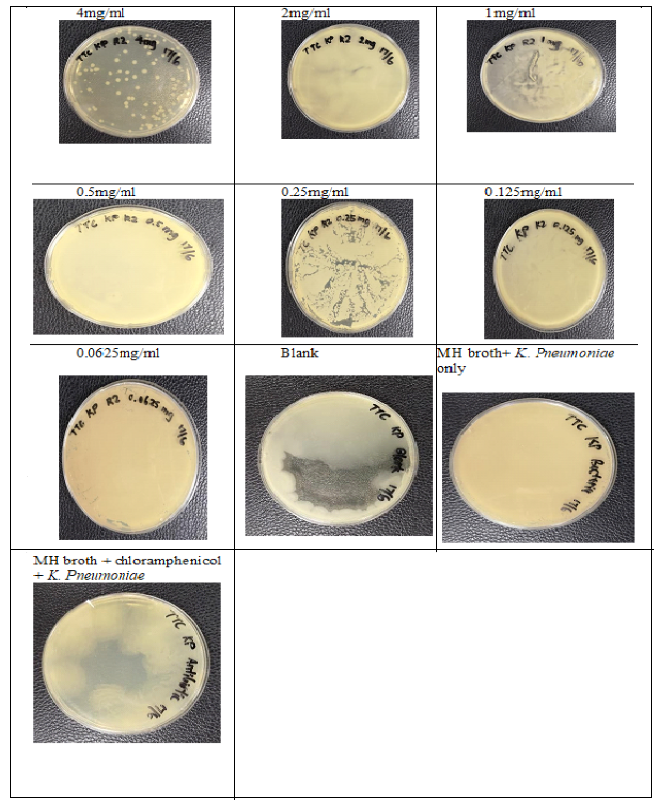
Antimicrobial acitivity against K. Pneumoniae
Figure 4 Growth of K. pneumoniae at 4, 2, 1, 0.5, 0.25, 0.125, 0.0625 mg/ml C. asiatica extract, blank, positive control and negative control
This study was conducted to evaluate the antimicrobial activity of C. Asiatica on 4 bacteria strains which are Escherichia coli, Bacillus pumilus, Klebsiella pneumoniae and Staphylococcus epidermidis. These bacterias were chosen because they are the most common that can be easily encountered in our daily life and can cause disease to individuals. Besides, this study also studies the free radical scavenging activity of the extract. Total phenolic content in C.asiatica was also studied as phenolic compounds are often the components that are responsible for the antioxidant properties of this medicinal plants.
C. asiatica was proved to have free radical scavenging radical effect in the research. This study discovered that the free radical scavenging activity of maceration ethanol extract of C asiatica at 100, 80, 60, 40, 20, 10 μg/mL are 52.7%, 48.8%, 46.4%, 41.6%, 40.2%, and 36.3% respectively. From the findings, it was found that C.asiatica did possess concentration- dependent free radical scavenging activity. As the concentration of C.asiatica extract increases, the absorbance value decreases, and the free radical scavenging activity of the extract increases. Another study conducted by Kulkarni et al. supports the finding that ethanol extract of C.asiatica did possess free radical scavenging activity. Although the study conducted by Kulkarni et al. was based on higher concentration, which are 200, 400, 600, 800, 1000 and 1200 μg/mL, however, from the graph plotted, it was found that there is the finding by this study is in coherent with the study performed by Kulkarni et al. . It is because the graph obtained from this study is consistent with that obtained by Kulkarni et al.. This study also portrayed that C.asiatica possess antioxidant activity even at a low concentration of 10 μg/ml, which imply that C.asiatica has a strong antioxidant activity. The study by Kulkarni et al. also shows that C.asiatica has higher antioxidant activity compared to Bacopa monnieri, which is another widely used traditional Ayurvedic medicine that is used for Alzheimer’s disease and improves brain function (14).
The free radical scavenging activity between the maceration extract and soxhlet extract of C.asiatica were found to be slightly different. The soxhlet extract of the C.asiatica was found to be having comparatively lower free radical scavenging activity at all concentrations compared to maceration extract. This finding is in agreement with the study by Mohapatra et al. which found out that maceration extraction method is superior to the heat reflux method in extraction of bioactive compounds from the C.asiatica. This may be due to exposure of the phytochemical compounds to continuous, high heat during the extraction method which will subsequently lead to deterioration of the antioxidant substances in C.asiatica. In the study for total phenolic content, Gallic acid was used as the standard. A standard curve was constructed based on the absorption value of Gallic acid at 760 nm for various concentrations which are 10, 20, 40, 60, 80, and 100 μg/ml, respectively. An equation was derived based on the standard curve constructed which was found to be Y=0.0144X-0.0297. The correlation coefficient R2 of the standard graph was found to be 0.9942. The value indicates that the absorbance value of Gallic acid at 760nm was highly related to the concentration. The absorbance value of maceration extract of C.asiatica was found to be equal to 0.269 at 760nm. By using the formulae derived from the standardcurve, the total phenolic contentof C. asiatica maceration extract was found to be 20.74 μg/ml Gallic acid equivalent. On the other hand, the absorbance value of Soxhlet extract was found to be 0.366 at 760nm. By using the formulae derived from the standard curve, the total phenolic content in C. asiatica Soxhlet extract was found to be 27.48 μg/mL Gallic acid equivalent(14,15).
According to the result of the study, C.asiatica was found to be having antimicrobial activitiy against E.coli. This is consistent with the finding of Dash et al. whereby the C.asiatica was suggested to be effective against the E.coli. Although there was a slight difference between the methodology used by Dash et al. and this study, there is still validity in the correlation between this study and study performed by Dash et al. The minimum inhibitory concentration (MIC) of C.asiatica against E.coli was found to be 4 mg/ml. It is because at 4mg/ml, the growth of E.coli was obviously inhibited to only around 100 colonies while in previous concentration which is 2mg/ml, there is turbidity shown all over the petri plate, which indicates visible growth of E.coli all over the plate. Based on the MIC, The minimum bactericidal concentration (MBC) was predicted to be 8mg/ml. In control wise, there is lack of inhibitory effect of chloramphenicol against E.coli most probably due to the development of antibiotic resistance in E.coli [16]. K.Pneumoniae was found to be sensitive to the antimicrobial activity of C. asiatica. This is validated by the study performed by Suresh et al. wherein the ethanol extract of C.asiatica showed positive inhibitory effect on the growth of K. Penumoniae. The minimum inhibitory concentration (MIC) of C.asiatica against K.pneumoniae was found to be 4mg/ml in this study. According to the observation, the growth of K.pneumoniae was suppressed to a few colonies at 4mg/ml while at 2mg/ml, there is still turbidity that indicates the growth of bacteria cells all over the plate. Based on MIC, the minimum bactericidal concentration (MBC) of C.asiatica against K.penumoniae was speculated to be 8mg/ml. The number of coloniesof K.pneumoniae found on the surface of petri plate was almost the same compared with E.coli. Thus, it is safe to conclude that C.asiatica is having comparable activity against E.coli and K. Pneumoniae, which are both gram-negative bacteria [17]. C.asiatica was found to be effective against S. Epidermidis. This finding can be supported by the study conducted by Sieberi et al.. It is because the bacterial growth was suppressed into colonies at 4mg/ml. However, if compared to the inhibitory effect found in E. coli and K pneumoniae, the inhibitory effect of C.asiatica and S.epidermidis was less significant as there are more bacteria colonies found on the surface of plate. Thus, it is coherent to S.epidermidis is less vulnerable to C.asiatica although it shares the same MIC with E.coli and K.pneumoniae [18,19]. C.asiatica did not portrayed inhibitory effect on B.pumilus with the concentration given which are 4mg/ml, 2mg/ml, 1mg/ml, 0.5mg/ml , 0.25mg/ml ,0.125 mg/ml and 0.0625 mg/ml. The positive control in which chloramphenicol was added to the nutrient broth containing B.pumilus confirmed the viability of the B.pumilus bacteria used in this study. There is still lack of study and evidence about the antimicrobial activity of C.asiatica on B.pumilus. Thus, there is lack of evidence to conclude that C.asiatica does not possess antibacterial activity against B.pumilus. According to comparative studies performed by Idris and Mohd Nadzir, other studies that investigated the activity of Casiatica on the Bacillus species did yield positive results. However, those studies utilize Bacillus cereus and Bacillus subtilis in their studies. Moreover, most of those studies were based on disc diffusion method, which only studies on the sensitivity of bacteria against the plant extract and did not give a value on the inhibitory concentration of C.asiatica on Bacillus species. There is also a possibility that C.asiatica only inhibit B.pumilus at a higher concentration [8].
It was found that C.asiatica was more potent on Gram-negative bacteria than on Gram- positive strains, thus acting as a broad spectrum. This can be validated by less number of bacterial colonies for E.coli and K.pneumoniae compared to B.pumilus and S. Pneumoniae at their respective minimum inhibitory concentration. These findings are consistent with other reported research works such as the study by Sieberi et al. and Ashok et al., and this could be attributed to the presence of a lipophilic outer membrane consisting of lipopolysaccharide molecules with an affinity for lipophilic molecules (18,20).
This study found that the % free radical scavenging of maceration ethanol extract of C asiatica at 100, 80, 60, 40, 20, 10 μg/mL were 52.7%, 48.8%, 46.4 Percentage, 41.6 Percentage, 40.2 Percentage, and 36.3 Percentage
respectively. The soxhlet extract of C asiatica also showed a similar result as the maceration
extract. This study shows that C asiatica possesses high potential of antioxidant activity. This study also showed that the total phenolic content in C.asiatica maceration and soxhlet extract at 1 mg/ml is 20.74 and 27.48 μg/mL Gallic acid equivalent (GAE) respectively. The study on the antimicrobial activity showed that C. asiatica has antimicrobial activity against E. coli,
K. pneumonia, and S. Epidermidis. On the other hand, B. pumilus was not inhibited by C. asiatica at the concentration tested. The MIC of C. asiatica for E. coli, K. pneumoniae and S. epidermidis was 4mg/ml.
The authors are highly thankful to the Faculty of Pharmacy, AIMST University, Bedong, Kedah D.A., Malaysia, for funding and providing facilities to carry out this research project.
Authors declare that there is no conflict of interests.
Clearly Auctoresonline and particularly Psychology and Mental Health Care Journal is dedicated to improving health care services for individuals and populations. The editorial boards' ability to efficiently recognize and share the global importance of health literacy with a variety of stakeholders. Auctoresonline publishing platform can be used to facilitate of optimal client-based services and should be added to health care professionals' repertoire of evidence-based health care resources.

Journal of Clinical Cardiology and Cardiovascular Intervention The submission and review process was adequate. However I think that the publication total value should have been enlightened in early fases. Thank you for all.

Journal of Women Health Care and Issues By the present mail, I want to say thank to you and tour colleagues for facilitating my published article. Specially thank you for the peer review process, support from the editorial office. I appreciate positively the quality of your journal.
Journal of Clinical Research and Reports I would be very delighted to submit my testimonial regarding the reviewer board and the editorial office. The reviewer board were accurate and helpful regarding any modifications for my manuscript. And the editorial office were very helpful and supportive in contacting and monitoring with any update and offering help. It was my pleasure to contribute with your promising Journal and I am looking forward for more collaboration.

We would like to thank the Journal of Thoracic Disease and Cardiothoracic Surgery because of the services they provided us for our articles. The peer-review process was done in a very excellent time manner, and the opinions of the reviewers helped us to improve our manuscript further. The editorial office had an outstanding correspondence with us and guided us in many ways. During a hard time of the pandemic that is affecting every one of us tremendously, the editorial office helped us make everything easier for publishing scientific work. Hope for a more scientific relationship with your Journal.

The peer-review process which consisted high quality queries on the paper. I did answer six reviewers’ questions and comments before the paper was accepted. The support from the editorial office is excellent.

Journal of Neuroscience and Neurological Surgery. I had the experience of publishing a research article recently. The whole process was simple from submission to publication. The reviewers made specific and valuable recommendations and corrections that improved the quality of my publication. I strongly recommend this Journal.

Dr. Katarzyna Byczkowska My testimonial covering: "The peer review process is quick and effective. The support from the editorial office is very professional and friendly. Quality of the Clinical Cardiology and Cardiovascular Interventions is scientific and publishes ground-breaking research on cardiology that is useful for other professionals in the field.

Thank you most sincerely, with regard to the support you have given in relation to the reviewing process and the processing of my article entitled "Large Cell Neuroendocrine Carcinoma of The Prostate Gland: A Review and Update" for publication in your esteemed Journal, Journal of Cancer Research and Cellular Therapeutics". The editorial team has been very supportive.

Testimony of Journal of Clinical Otorhinolaryngology: work with your Reviews has been a educational and constructive experience. The editorial office were very helpful and supportive. It was a pleasure to contribute to your Journal.

Dr. Bernard Terkimbi Utoo, I am happy to publish my scientific work in Journal of Women Health Care and Issues (JWHCI). The manuscript submission was seamless and peer review process was top notch. I was amazed that 4 reviewers worked on the manuscript which made it a highly technical, standard and excellent quality paper. I appreciate the format and consideration for the APC as well as the speed of publication. It is my pleasure to continue with this scientific relationship with the esteem JWHCI.

This is an acknowledgment for peer reviewers, editorial board of Journal of Clinical Research and Reports. They show a lot of consideration for us as publishers for our research article “Evaluation of the different factors associated with side effects of COVID-19 vaccination on medical students, Mutah university, Al-Karak, Jordan”, in a very professional and easy way. This journal is one of outstanding medical journal.
Dear Hao Jiang, to Journal of Nutrition and Food Processing We greatly appreciate the efficient, professional and rapid processing of our paper by your team. If there is anything else we should do, please do not hesitate to let us know. On behalf of my co-authors, we would like to express our great appreciation to editor and reviewers.

As an author who has recently published in the journal "Brain and Neurological Disorders". I am delighted to provide a testimonial on the peer review process, editorial office support, and the overall quality of the journal. The peer review process at Brain and Neurological Disorders is rigorous and meticulous, ensuring that only high-quality, evidence-based research is published. The reviewers are experts in their fields, and their comments and suggestions were constructive and helped improve the quality of my manuscript. The review process was timely and efficient, with clear communication from the editorial office at each stage. The support from the editorial office was exceptional throughout the entire process. The editorial staff was responsive, professional, and always willing to help. They provided valuable guidance on formatting, structure, and ethical considerations, making the submission process seamless. Moreover, they kept me informed about the status of my manuscript and provided timely updates, which made the process less stressful. The journal Brain and Neurological Disorders is of the highest quality, with a strong focus on publishing cutting-edge research in the field of neurology. The articles published in this journal are well-researched, rigorously peer-reviewed, and written by experts in the field. The journal maintains high standards, ensuring that readers are provided with the most up-to-date and reliable information on brain and neurological disorders. In conclusion, I had a wonderful experience publishing in Brain and Neurological Disorders. The peer review process was thorough, the editorial office provided exceptional support, and the journal's quality is second to none. I would highly recommend this journal to any researcher working in the field of neurology and brain disorders.

Dear Agrippa Hilda, Journal of Neuroscience and Neurological Surgery, Editorial Coordinator, I trust this message finds you well. I want to extend my appreciation for considering my article for publication in your esteemed journal. I am pleased to provide a testimonial regarding the peer review process and the support received from your editorial office. The peer review process for my paper was carried out in a highly professional and thorough manner. The feedback and comments provided by the authors were constructive and very useful in improving the quality of the manuscript. This rigorous assessment process undoubtedly contributes to the high standards maintained by your journal.

International Journal of Clinical Case Reports and Reviews. I strongly recommend to consider submitting your work to this high-quality journal. The support and availability of the Editorial staff is outstanding and the review process was both efficient and rigorous.

Thank you very much for publishing my Research Article titled “Comparing Treatment Outcome Of Allergic Rhinitis Patients After Using Fluticasone Nasal Spray And Nasal Douching" in the Journal of Clinical Otorhinolaryngology. As Medical Professionals we are immensely benefited from study of various informative Articles and Papers published in this high quality Journal. I look forward to enriching my knowledge by regular study of the Journal and contribute my future work in the field of ENT through the Journal for use by the medical fraternity. The support from the Editorial office was excellent and very prompt. I also welcome the comments received from the readers of my Research Article.

Dear Erica Kelsey, Editorial Coordinator of Cancer Research and Cellular Therapeutics Our team is very satisfied with the processing of our paper by your journal. That was fast, efficient, rigorous, but without unnecessary complications. We appreciated the very short time between the submission of the paper and its publication on line on your site.

I am very glad to say that the peer review process is very successful and fast and support from the Editorial Office. Therefore, I would like to continue our scientific relationship for a long time. And I especially thank you for your kindly attention towards my article. Have a good day!

"We recently published an article entitled “Influence of beta-Cyclodextrins upon the Degradation of Carbofuran Derivatives under Alkaline Conditions" in the Journal of “Pesticides and Biofertilizers” to show that the cyclodextrins protect the carbamates increasing their half-life time in the presence of basic conditions This will be very helpful to understand carbofuran behaviour in the analytical, agro-environmental and food areas. We greatly appreciated the interaction with the editor and the editorial team; we were particularly well accompanied during the course of the revision process, since all various steps towards publication were short and without delay".

I would like to express my gratitude towards you process of article review and submission. I found this to be very fair and expedient. Your follow up has been excellent. I have many publications in national and international journal and your process has been one of the best so far. Keep up the great work.

We are grateful for this opportunity to provide a glowing recommendation to the Journal of Psychiatry and Psychotherapy. We found that the editorial team were very supportive, helpful, kept us abreast of timelines and over all very professional in nature. The peer review process was rigorous, efficient and constructive that really enhanced our article submission. The experience with this journal remains one of our best ever and we look forward to providing future submissions in the near future.

I am very pleased to serve as EBM of the journal, I hope many years of my experience in stem cells can help the journal from one way or another. As we know, stem cells hold great potential for regenerative medicine, which are mostly used to promote the repair response of diseased, dysfunctional or injured tissue using stem cells or their derivatives. I think Stem Cell Research and Therapeutics International is a great platform to publish and share the understanding towards the biology and translational or clinical application of stem cells.

I would like to give my testimony in the support I have got by the peer review process and to support the editorial office where they were of asset to support young author like me to be encouraged to publish their work in your respected journal and globalize and share knowledge across the globe. I really give my great gratitude to your journal and the peer review including the editorial office.

I am delighted to publish our manuscript entitled "A Perspective on Cocaine Induced Stroke - Its Mechanisms and Management" in the Journal of Neuroscience and Neurological Surgery. The peer review process, support from the editorial office, and quality of the journal are excellent. The manuscripts published are of high quality and of excellent scientific value. I recommend this journal very much to colleagues.

Dr.Tania Muñoz, My experience as researcher and author of a review article in The Journal Clinical Cardiology and Interventions has been very enriching and stimulating. The editorial team is excellent, performs its work with absolute responsibility and delivery. They are proactive, dynamic and receptive to all proposals. Supporting at all times the vast universe of authors who choose them as an option for publication. The team of review specialists, members of the editorial board, are brilliant professionals, with remarkable performance in medical research and scientific methodology. Together they form a frontline team that consolidates the JCCI as a magnificent option for the publication and review of high-level medical articles and broad collective interest. I am honored to be able to share my review article and open to receive all your comments.

“The peer review process of JPMHC is quick and effective. Authors are benefited by good and professional reviewers with huge experience in the field of psychology and mental health. The support from the editorial office is very professional. People to contact to are friendly and happy to help and assist any query authors might have. Quality of the Journal is scientific and publishes ground-breaking research on mental health that is useful for other professionals in the field”.

Dear editorial department: On behalf of our team, I hereby certify the reliability and superiority of the International Journal of Clinical Case Reports and Reviews in the peer review process, editorial support, and journal quality. Firstly, the peer review process of the International Journal of Clinical Case Reports and Reviews is rigorous, fair, transparent, fast, and of high quality. The editorial department invites experts from relevant fields as anonymous reviewers to review all submitted manuscripts. These experts have rich academic backgrounds and experience, and can accurately evaluate the academic quality, originality, and suitability of manuscripts. The editorial department is committed to ensuring the rigor of the peer review process, while also making every effort to ensure a fast review cycle to meet the needs of authors and the academic community. Secondly, the editorial team of the International Journal of Clinical Case Reports and Reviews is composed of a group of senior scholars and professionals with rich experience and professional knowledge in related fields. The editorial department is committed to assisting authors in improving their manuscripts, ensuring their academic accuracy, clarity, and completeness. Editors actively collaborate with authors, providing useful suggestions and feedback to promote the improvement and development of the manuscript. We believe that the support of the editorial department is one of the key factors in ensuring the quality of the journal. Finally, the International Journal of Clinical Case Reports and Reviews is renowned for its high- quality articles and strict academic standards. The editorial department is committed to publishing innovative and academically valuable research results to promote the development and progress of related fields. The International Journal of Clinical Case Reports and Reviews is reasonably priced and ensures excellent service and quality ratio, allowing authors to obtain high-level academic publishing opportunities in an affordable manner. I hereby solemnly declare that the International Journal of Clinical Case Reports and Reviews has a high level of credibility and superiority in terms of peer review process, editorial support, reasonable fees, and journal quality. Sincerely, Rui Tao.

Clinical Cardiology and Cardiovascular Interventions I testity the covering of the peer review process, support from the editorial office, and quality of the journal.

Clinical Cardiology and Cardiovascular Interventions, we deeply appreciate the interest shown in our work and its publication. It has been a true pleasure to collaborate with you. The peer review process, as well as the support provided by the editorial office, have been exceptional, and the quality of the journal is very high, which was a determining factor in our decision to publish with you.
The peer reviewers process is quick and effective, the supports from editorial office is excellent, the quality of journal is high. I would like to collabroate with Internatioanl journal of Clinical Case Reports and Reviews journal clinically in the future time.

Clinical Cardiology and Cardiovascular Interventions, I would like to express my sincerest gratitude for the trust placed in our team for the publication in your journal. It has been a true pleasure to collaborate with you on this project. I am pleased to inform you that both the peer review process and the attention from the editorial coordination have been excellent. Your team has worked with dedication and professionalism to ensure that your publication meets the highest standards of quality. We are confident that this collaboration will result in mutual success, and we are eager to see the fruits of this shared effort.

Dear Dr. Jessica Magne, Editorial Coordinator 0f Clinical Cardiology and Cardiovascular Interventions, I hope this message finds you well. I want to express my utmost gratitude for your excellent work and for the dedication and speed in the publication process of my article titled "Navigating Innovation: Qualitative Insights on Using Technology for Health Education in Acute Coronary Syndrome Patients." I am very satisfied with the peer review process, the support from the editorial office, and the quality of the journal. I hope we can maintain our scientific relationship in the long term.
Dear Monica Gissare, - Editorial Coordinator of Nutrition and Food Processing. ¨My testimony with you is truly professional, with a positive response regarding the follow-up of the article and its review, you took into account my qualities and the importance of the topic¨.

Dear Dr. Jessica Magne, Editorial Coordinator 0f Clinical Cardiology and Cardiovascular Interventions, The review process for the article “The Handling of Anti-aggregants and Anticoagulants in the Oncologic Heart Patient Submitted to Surgery” was extremely rigorous and detailed. From the initial submission to the final acceptance, the editorial team at the “Journal of Clinical Cardiology and Cardiovascular Interventions” demonstrated a high level of professionalism and dedication. The reviewers provided constructive and detailed feedback, which was essential for improving the quality of our work. Communication was always clear and efficient, ensuring that all our questions were promptly addressed. The quality of the “Journal of Clinical Cardiology and Cardiovascular Interventions” is undeniable. It is a peer-reviewed, open-access publication dedicated exclusively to disseminating high-quality research in the field of clinical cardiology and cardiovascular interventions. The journal's impact factor is currently under evaluation, and it is indexed in reputable databases, which further reinforces its credibility and relevance in the scientific field. I highly recommend this journal to researchers looking for a reputable platform to publish their studies.

Dear Editorial Coordinator of the Journal of Nutrition and Food Processing! "I would like to thank the Journal of Nutrition and Food Processing for including and publishing my article. The peer review process was very quick, movement and precise. The Editorial Board has done an extremely conscientious job with much help, valuable comments and advices. I find the journal very valuable from a professional point of view, thank you very much for allowing me to be part of it and I would like to participate in the future!”

Dealing with The Journal of Neurology and Neurological Surgery was very smooth and comprehensive. The office staff took time to address my needs and the response from editors and the office was prompt and fair. I certainly hope to publish with this journal again.Their professionalism is apparent and more than satisfactory. Susan Weiner

My Testimonial Covering as fellowing: Lin-Show Chin. The peer reviewers process is quick and effective, the supports from editorial office is excellent, the quality of journal is high. I would like to collabroate with Internatioanl journal of Clinical Case Reports and Reviews.

My experience publishing in Psychology and Mental Health Care was exceptional. The peer review process was rigorous and constructive, with reviewers providing valuable insights that helped enhance the quality of our work. The editorial team was highly supportive and responsive, making the submission process smooth and efficient. The journal's commitment to high standards and academic rigor makes it a respected platform for quality research. I am grateful for the opportunity to publish in such a reputable journal.
My experience publishing in International Journal of Clinical Case Reports and Reviews was exceptional. I Come forth to Provide a Testimonial Covering the Peer Review Process and the editorial office for the Professional and Impartial Evaluation of the Manuscript.

I would like to offer my testimony in the support. I have received through the peer review process and support the editorial office where they are to support young authors like me, encourage them to publish their work in your esteemed journals, and globalize and share knowledge globally. I really appreciate your journal, peer review, and editorial office.
Dear Agrippa Hilda- Editorial Coordinator of Journal of Neuroscience and Neurological Surgery, "The peer review process was very quick and of high quality, which can also be seen in the articles in the journal. The collaboration with the editorial office was very good."

I would like to express my sincere gratitude for the support and efficiency provided by the editorial office throughout the publication process of my article, “Delayed Vulvar Metastases from Rectal Carcinoma: A Case Report.” I greatly appreciate the assistance and guidance I received from your team, which made the entire process smooth and efficient. The peer review process was thorough and constructive, contributing to the overall quality of the final article. I am very grateful for the high level of professionalism and commitment shown by the editorial staff, and I look forward to maintaining a long-term collaboration with the International Journal of Clinical Case Reports and Reviews.
To Dear Erin Aust, I would like to express my heartfelt appreciation for the opportunity to have my work published in this esteemed journal. The entire publication process was smooth and well-organized, and I am extremely satisfied with the final result. The Editorial Team demonstrated the utmost professionalism, providing prompt and insightful feedback throughout the review process. Their clear communication and constructive suggestions were invaluable in enhancing my manuscript, and their meticulous attention to detail and dedication to quality are truly commendable. Additionally, the support from the Editorial Office was exceptional. From the initial submission to the final publication, I was guided through every step of the process with great care and professionalism. The team's responsiveness and assistance made the entire experience both easy and stress-free. I am also deeply impressed by the quality and reputation of the journal. It is an honor to have my research featured in such a respected publication, and I am confident that it will make a meaningful contribution to the field.

"I am grateful for the opportunity of contributing to [International Journal of Clinical Case Reports and Reviews] and for the rigorous review process that enhances the quality of research published in your esteemed journal. I sincerely appreciate the time and effort of your team who have dedicatedly helped me in improvising changes and modifying my manuscript. The insightful comments and constructive feedback provided have been invaluable in refining and strengthening my work".

I thank the ‘Journal of Clinical Research and Reports’ for accepting this article for publication. This is a rigorously peer reviewed journal which is on all major global scientific data bases. I note the review process was prompt, thorough and professionally critical. It gave us an insight into a number of important scientific/statistical issues. The review prompted us to review the relevant literature again and look at the limitations of the study. The peer reviewers were open, clear in the instructions and the editorial team was very prompt in their communication. This journal certainly publishes quality research articles. I would recommend the journal for any future publications.

Dear Jessica Magne, with gratitude for the joint work. Fast process of receiving and processing the submitted scientific materials in “Clinical Cardiology and Cardiovascular Interventions”. High level of competence of the editors with clear and correct recommendations and ideas for enriching the article.

We found the peer review process quick and positive in its input. The support from the editorial officer has been very agile, always with the intention of improving the article and taking into account our subsequent corrections.

My article, titled 'No Way Out of the Smartphone Epidemic Without Considering the Insights of Brain Research,' has been republished in the International Journal of Clinical Case Reports and Reviews. The review process was seamless and professional, with the editors being both friendly and supportive. I am deeply grateful for their efforts.
To Dear Erin Aust – Editorial Coordinator of Journal of General Medicine and Clinical Practice! I declare that I am absolutely satisfied with your work carried out with great competence in following the manuscript during the various stages from its receipt, during the revision process to the final acceptance for publication. Thank Prof. Elvira Farina

Dear Jessica, and the super professional team of the ‘Clinical Cardiology and Cardiovascular Interventions’ I am sincerely grateful to the coordinated work of the journal team for the no problem with the submission of my manuscript: “Cardiometabolic Disorders in A Pregnant Woman with Severe Preeclampsia on the Background of Morbid Obesity (Case Report).” The review process by 5 experts was fast, and the comments were professional, which made it more specific and academic, and the process of publication and presentation of the article was excellent. I recommend that my colleagues publish articles in this journal, and I am interested in further scientific cooperation. Sincerely and best wishes, Dr. Oleg Golyanovskiy.

Dear Ashley Rosa, Editorial Coordinator of the journal - Psychology and Mental Health Care. " The process of obtaining publication of my article in the Psychology and Mental Health Journal was positive in all areas. The peer review process resulted in a number of valuable comments, the editorial process was collaborative and timely, and the quality of this journal has been quickly noticed, resulting in alternative journals contacting me to publish with them." Warm regards, Susan Anne Smith, PhD. Australian Breastfeeding Association.

Dear Jessica Magne, Editorial Coordinator, Clinical Cardiology and Cardiovascular Interventions, Auctores Publishing LLC. I appreciate the journal (JCCI) editorial office support, the entire team leads were always ready to help, not only on technical front but also on thorough process. Also, I should thank dear reviewers’ attention to detail and creative approach to teach me and bring new insights by their comments. Surely, more discussions and introduction of other hemodynamic devices would provide better prevention and management of shock states. Your efforts and dedication in presenting educational materials in this journal are commendable. Best wishes from, Farahnaz Fallahian.
Dear Maria Emerson, Editorial Coordinator, International Journal of Clinical Case Reports and Reviews, Auctores Publishing LLC. I am delighted to have published our manuscript, "Acute Colonic Pseudo-Obstruction (ACPO): A rare but serious complication following caesarean section." I want to thank the editorial team, especially Maria Emerson, for their prompt review of the manuscript, quick responses to queries, and overall support. Yours sincerely Dr. Victor Olagundoye.

Dear Ashley Rosa, Editorial Coordinator, International Journal of Clinical Case Reports and Reviews. Many thanks for publishing this manuscript after I lost confidence the editors were most helpful, more than other journals Best wishes from, Susan Anne Smith, PhD. Australian Breastfeeding Association.

Dear Agrippa Hilda, Editorial Coordinator, Journal of Neuroscience and Neurological Surgery. The entire process including article submission, review, revision, and publication was extremely easy. The journal editor was prompt and helpful, and the reviewers contributed to the quality of the paper. Thank you so much! Eric Nussbaum, MD
Dr Hala Al Shaikh This is to acknowledge that the peer review process for the article ’ A Novel Gnrh1 Gene Mutation in Four Omani Male Siblings, Presentation and Management ’ sent to the International Journal of Clinical Case Reports and Reviews was quick and smooth. The editorial office was prompt with easy communication.

Dear Erin Aust, Editorial Coordinator, Journal of General Medicine and Clinical Practice. We are pleased to share our experience with the “Journal of General Medicine and Clinical Practice”, following the successful publication of our article. The peer review process was thorough and constructive, helping to improve the clarity and quality of the manuscript. We are especially thankful to Ms. Erin Aust, the Editorial Coordinator, for her prompt communication and continuous support throughout the process. Her professionalism ensured a smooth and efficient publication experience. The journal upholds high editorial standards, and we highly recommend it to fellow researchers seeking a credible platform for their work. Best wishes By, Dr. Rakhi Mishra.

Dear Jessica Magne, Editorial Coordinator, Clinical Cardiology and Cardiovascular Interventions, Auctores Publishing LLC. The peer review process of the journal of Clinical Cardiology and Cardiovascular Interventions was excellent and fast, as was the support of the editorial office and the quality of the journal. Kind regards Walter F. Riesen Prof. Dr. Dr. h.c. Walter F. Riesen.

Dear Ashley Rosa, Editorial Coordinator, International Journal of Clinical Case Reports and Reviews, Auctores Publishing LLC. Thank you for publishing our article, Exploring Clozapine's Efficacy in Managing Aggression: A Multiple Single-Case Study in Forensic Psychiatry in the international journal of clinical case reports and reviews. We found the peer review process very professional and efficient. The comments were constructive, and the whole process was efficient. On behalf of the co-authors, I would like to thank you for publishing this article. With regards, Dr. Jelle R. Lettinga.

Dear Clarissa Eric, Editorial Coordinator, Journal of Clinical Case Reports and Studies, I would like to express my deep admiration for the exceptional professionalism demonstrated by your journal. I am thoroughly impressed by the speed of the editorial process, the substantive and insightful reviews, and the meticulous preparation of the manuscript for publication. Additionally, I greatly appreciate the courteous and immediate responses from your editorial office to all my inquiries. Best Regards, Dariusz Ziora

Dear Chrystine Mejia, Editorial Coordinator, Journal of Neurodegeneration and Neurorehabilitation, Auctores Publishing LLC, We would like to thank the editorial team for the smooth and high-quality communication leading up to the publication of our article in the Journal of Neurodegeneration and Neurorehabilitation. The reviewers have extensive knowledge in the field, and their relevant questions helped to add value to our publication. Kind regards, Dr. Ravi Shrivastava.

Dear Clarissa Eric, Editorial Coordinator, Journal of Clinical Case Reports and Studies, Auctores Publishing LLC, USA Office: +1-(302)-520-2644. I would like to express my sincere appreciation for the efficient and professional handling of my case report by the ‘Journal of Clinical Case Reports and Studies’. The peer review process was not only fast but also highly constructive—the reviewers’ comments were clear, relevant, and greatly helped me improve the quality and clarity of my manuscript. I also received excellent support from the editorial office throughout the process. Communication was smooth and timely, and I felt well guided at every stage, from submission to publication. The overall quality and rigor of the journal are truly commendable. I am pleased to have published my work with Journal of Clinical Case Reports and Studies, and I look forward to future opportunities for collaboration. Sincerely, Aline Tollet, UCLouvain.

Dear Ms. Mayra Duenas, Editorial Coordinator, International Journal of Clinical Case Reports and Reviews. “The International Journal of Clinical Case Reports and Reviews represented the “ideal house” to share with the research community a first experience with the use of the Simeox device for speech rehabilitation. High scientific reputation and attractive website communication were first determinants for the selection of this Journal, and the following submission process exceeded expectations: fast but highly professional peer review, great support by the editorial office, elegant graphic layout. Exactly what a dynamic research team - also composed by allied professionals - needs!" From, Chiara Beccaluva, PT - Italy.

Dear Maria Emerson, Editorial Coordinator, we have deeply appreciated the professionalism demonstrated by the International Journal of Clinical Case Reports and Reviews. The reviewers have extensive knowledge of our field and have been very efficient and fast in supporting the process. I am really looking forward to further collaboration. Thanks. Best regards, Dr. Claudio Ligresti
Dear Chrystine Mejia, Editorial Coordinator, Journal of Neurodegeneration and Neurorehabilitation. “The peer review process was efficient and constructive, and the editorial office provided excellent communication and support throughout. The journal ensures scientific rigor and high editorial standards, while also offering a smooth and timely publication process. We sincerely appreciate the work of the editorial team in facilitating the dissemination of innovative approaches such as the Bonori Method.” Best regards, Dr. Giselle Pentón-Rol.
